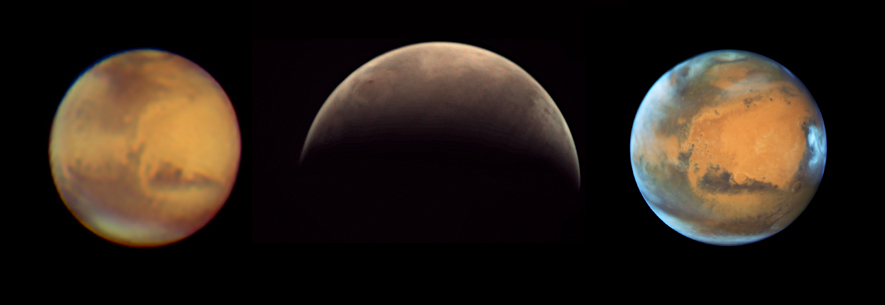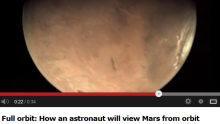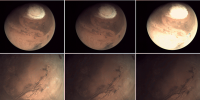The news is out: our little VMC webcam on board Mars Express has achieved adulthood, of sorts! In a web article on 25 May, we announced that the VMC camera is being adopted as a professional science instrument.

Mars seen in May 2016 in three different views. Full details via https://www.esa.int/marstriptych2016 Credit: D. O’Donnell – ESA/Mars Express/VMC CC BY-SA 3.0 IGO – ESA/NASA/Hubble
The article reads, in part:
This spring, ESA began working with the Planetary Sciences Group of the University of the Basque Country, Spain, for an initial two years to develop software and conduct studies of images, effectively promoting the humble camera to the level of professional science instrument.
“The analysis will help us understand the global martian context of data acquired from other instruments, provide data on clouds, dust and atmospheric structures and enable surface features to be accurately characterised, for example, by tracking variations in the Mars polar ice cap,” says Agustín Sánchez-Lavega, heading the group.
ESA’s Mars Express Project Scientist Dmitri Titov is delighted that the camera is opening up a new range of investigations at Mars: “Cloud tracking and dust storm monitoring, for example, are significant topics in the planetary community, and it will allow us to extend Mars Express science ‘into the atmosphere’, filling a gap in the spacecraft’s science portfolio.
The good news is that the transition to a science instrument won’t interfere with the ongoing delivery of VMC images for immediate public viewing and for continued use in outreach, education and citizen science. You remain more than welcome (highly encouraged, in fact!) to access the image sets and use them for your own analysis, processing and sharing (details on CC licensing here).
Working on VMC outreach, education and PR has been one of the most interesting and satisfying projects I’ve been involved with here at ESOC in recent years. I have thoroughly enjoyed being in touch with, and working with, a lot of enthusiastic folks – some within ESA, many external – all of whom have been motivated by the love of science, interest in Mars, support for education and working with an active community.
While I thoroughly enjoyed seeing (and sharing) the many VMC submissions that people on several continents sent it over the years, the most enjoyable activity for me was definitely the 2015 VMC Imaging Campaign aimed at schools, astronomy clubs, science centres and other youth groups.
The level of participation was fabulous (25 groups from the US and Europe) and the resulting work was really well done. It was a genuine pleasure to work with the MEX flight control team here to host a series of Google Hangouts, issue the challenge, receive the imaging requests and then actually conduct the dedicated observations. This might have been the first-ever allocation of multiple orbits of an interplanetary craft to schools and young folks! And it was also a pleasure to see that some groups chose to submit artistic work based on the resulting images, in addition to those who sent in more traditional science projects.
It was also a pleasure working with pro-, semi-pro- and amateur (but v. enthusiastic) planetary science nuts located all over the place!
One of the most active supporters of VMC since the beginning has been Emily Lakdawalla – herself a planetary scientist – who blogs over at the Planetary Society. Emily has done an excellent job over many years highlighting numerous ESA missions, and she was a keen ‘early adopter’ when the VMC images first became available in 2007/08. She promoted and shared VMC images, and designed and hosted online tutorials to help those interested in working with the images learn some of the techniques, and she inspired many others to get involved.
I asked Emily for a few comments, and she sent in this:
The VMC demonstrates the power of a simple camera for exciting the public about the adventure of space exploration. Its images are not large but they are the only ones arriving from any Mars spacecraft that show us Mars as a round planet in all its changing phases and seasons – a view out the porthole of an interplanetary ship. I’d like to see simple, small, wide-angle cameras on all spacecraft to provide context to tell the story of robotic space exploration.
It’s appropriate, however, to take this opportunity to thank everyone who has contributed to VMC since its recommissioning in 2007. People have contributed time, software, knowledge, support to outreach activities, organisational efforts and enthusiasm – and so much more – helping make the VMC outreach effort a real success!
To everyone here, in alphabetical order, a huge thanks!
- Stuart Atkinson
- Johannes Bauer
- Maria Bennett
- Jean-Pierre Bibring
- Michel Breitfellner
- Marcello Cappelletti
- Alejandro Cardesin
- Michel Denis
- Bill Dunford
- Doug Ellison
- Paolo Ferri
- James Godfrey
- Brigitte Gondet
- Hannes Griebel
- Andy Johnstone
- Michael Khan
- Rene Kloos
- Emily Lakdawalla
- Daniel Lakey
- Jocelyne Landeau-Constantin
- Luke Lucas
- Stefan Luders
- Mike Malaska
- Thomas Ormston
- Gordan Ugarkovic
- Manfred Warhaut
- Simon Wood
If I inadvertently left someone’s name off the thanks list, DO let me know!!!!
Last but by no means least, I’d like to thank everyone who has ever downloaded, tinkered with, mashed up, colour-processed, artistically rendered, analysed, processed, shared or in any other way had total fun messing with VMC images. You guys are an inspiring community and it has been your enthusiasm that has made the VMC project a success.
If you’re looking for a nice, historical overview of VMC activities with many updates from the folks who did a lot of the work, there’s no better place than the VMC thread over at UnmannedSpaceFlight.
PS: As Emily pointed out in a separate email, a couple of our VMC community members have since gone on to great things: Both Mike Malaska and Bill Dunford have been absorbed by NASA/JPL!



Discussion: no comments